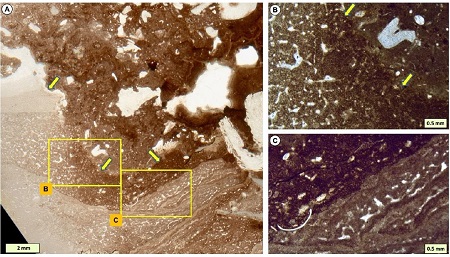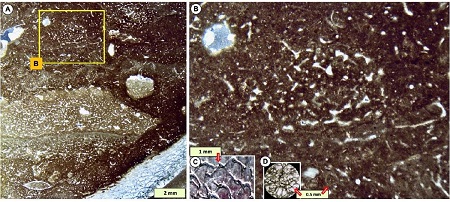In recent years, a particular pattern of marl tuffs has attracted increasing attention from geological colleagues and has become one of the major international hot topics. Think of a pattern consisting of two components, in biogenic limestones of deep-time: a) dark-colored ellipsoidal areas of various sizes and shapes, and b) curved light-colored areas filling the space between the ellipses. Is the pattern made of: 1) dark ellipsoidal objects with lightcoloured intervening spaces, or 2) a light-coloured complex curved framework with a dark infilling? This conundrum lies at the heart of the problem of distinguishing clotted micrite from sponges in micritic limestones.
Some curved structures resemble published images of interpreted sponges, raising the question of their nature, relevant to many carbonate studies including reefs and mud mounds throughout the Phanerozoic. A conundrum lies at the heart of the problem of distinguishing clotted micrite from sponges in micritic limestones. Understanding this issue is relevant for many carbonate studies in the Phanerozoic rock record, which include the widespread occurrence of reefs and mud mounds; the interpretations of presence of sponges are not necessarily always justified, affecting assessment of faunal assemblages, sedimentary processes and diagenesis.
Recently, Prof. Yue Li and Dr. Qi-jian Li from Nanjing Institute of Geology and Palaeontology, Chinese Academy of Sciences (NIGPAS) and his collaborators from Brunel University try to demonstrate the issue mentioned above by using material from Early Silurian patch reefs rich in such complex fabrics. The results have been published online in the Sedimentary Record, an open access journal hosted by the International Society for Sedimentary Geology (SEPM).
The study describes Early Silurian carbonate reef facies in the Ningqiang Formation containing amalgamated micritic masses, commonly layered, interpreted to have formed by bacterial processes creating clotted fabrics. In most cases, cavity infills comprise fabrics we interpret to be clotted micrite masses, and the layering presumably represents multiple events of infilling of open cavities (Fig. 1), perhaps as microbial micrites. Comparative images of modern lithistid desmas and keratose fibres and show that the size of lithistid desmas is comparable to the curved sparitic features in the Ningqiang Formation sediments, although keratose fibres are much smaller (Fig. 2).
The implication of this work is that studies reporting lithistid and keratose sponges in limestones in the Phanerozoic records may warrant careful consideration of the interpretation of presence of sponges, that may have an impact on discussions of sedimentology and diagenesis, and of sponge palaeobiology and evolution. The attempt to identify keratose sponges, using 3D reconstruction that involved destructive grinding, is difficult to achieve, but may be necessary for confirmation. The arguments presented in this study have potential wider implications for the analysis of other carbonate structures, such as mud mounds in Devonian that include fabrics interpreted as sponges.
This study was jointly supported by the Youth Innovation Promotion Association of CAS, grants from the Strategic Priority Research Program (B) of CAS and the National Natural Science Foundation of China.
Reference: Stephen Kershaw, Qijian Li & Yue Li. 2021. Addressing a Phanerozoic carbonate facies conundrum—sponges or clotted micrite? Evidence from Early Silurian reefs, South China Block. Sedimentary Record, DOI:10.2110/sedred.2021.1.03.

Figure 1.(A) Plane-polarised light (PPL) view of bioturbated wackestone reef fill, with margin of irregular cavity (bottom and left). Large white areas are spar-filled cavities lacking sediment. (B and C) Cross-polarised light (XPL) views of enlargements of the two boxes in (A) showing details of cavity margin and contrast between wackestone reef matrix and amalgamated micritic cavity fills, that are layered. Yellow arrows in (A) and (B) mark the cavity edge. Middle Huashitou reef, Xuanhe, Sichuan Province.

Figure 2. (A) View of amalgamated micrite with a second-generation cavity (lower centre) also filled with amalgamated micrite that is partly layered; a smaller round cavity, partly-filled, is shown centre-right. (B) Details of yellow box in (A) emphasising the round mass of sparite that might be a sponge. (C) Modern lithistid sponge desmas in transmitted light; note the difference in scale. (D) Modern keratose sponge fibres, at the same scale as the main picture, from an unidentified sponge, Bahamas.
Download:
